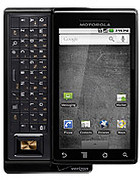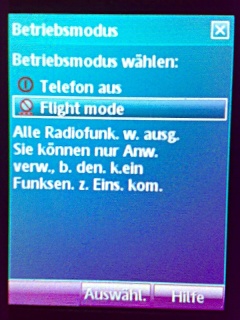Sunday, December 20. 2009
Android smartphone coming up

Or: A review of the Nokia N73
The history of my cell phones had its preliminary end in January 2007, almost three years ago, when I got my Nokia N73, a Symbian S60 based device. I was quite satisfied with it, and it was quite robust as well. I could sync contacts, calendar and tasks with Evolution via Bluetooth and SyncML by the help of OpenSync. I regularly used the e-mail client with IMAP/TLS and SMTP/TLS. The built-in browser did its job, despite its bugs. I bought a license for the LCG Jukebox app to be able to play Ogg Vorbis files. The cell’s camera was OK, though not very fast to launch; a quick sneaky snap was almost impossible. Features that I never tried were video calls or Push-To-Talk.
After a while I used it more and more extensively for internet access. It was my morning newspaper on the train during the week and at the breakfast table on the weekends. I had to cope with websites that didn’t provide a “microbrowser” friendly http://m.whatever.com/ version. I used a dedicated app to access timetables of the local public transport system. I used the non-GPS(!) based geolocation capabilities of Google Maps. I used the IM client Fring and bought a license for the Identi.ca/Twitter/Facebook/Google Reader client Gravity. Because of the browser’s bugs I installed Opera Mini. But I had severe memory problems, I couldn’t run no two of them at once—so quite the behavior of the Crapple diePhone. Also, there was always a different and minimalistic browser launching from a text or from Gravity. A cumbersome copy & paste of a URL into the “real” browser killed Gravity. I had to fav tweets or dents to look at URLs on the PC at a later time; I could thus hardly dare to retweet them from the cell.
As it was a branded device, there were apparently never any software updates available, although it definitely had its flaws. It took me 2½ years to finally notice that I should have faked its device ID so that I could’ve updated it as if it were unbranded. But after those three years I decided that it was just too late to mess around with it, as I thought it’s time for something that comes up to my needs.
Coming up: Android
 I’d never buy something from Crapple, so it’s an Android what I’ll get. In contrary to the diePhone, this software base and app market by Google is open—it runs on Linux! As hardware incarnation I want to have the Motorola Milestone, a.k.a. Droid in the US. Originally I targeted at the HTC Hero, but the Milestone has some more appealing features like a hardware keyboard, larger LCD resolution and a more masculine style. In contrary to the Droid, its LCD has multi-touch. I’ll rather use it as PDA than as a phone. I’ll welcome “apps for everything”, especially those which work online, e.g. for social nets, newsfeeds, etc. It has Wi-Fi and GPS with Google Maps Navigation (Yes, also in Europe!). Contacts and calendar are automatically available via Google’s web apps and can be used from within Gnome Evolution without syncing. It has a plain 3.5 mm audio jack and a USB connector. This gadget will cost me more than €400, but at least it won’t be branded or tied to a long-lasting contract. Let’s see where its price is at in January.
I’d never buy something from Crapple, so it’s an Android what I’ll get. In contrary to the diePhone, this software base and app market by Google is open—it runs on Linux! As hardware incarnation I want to have the Motorola Milestone, a.k.a. Droid in the US. Originally I targeted at the HTC Hero, but the Milestone has some more appealing features like a hardware keyboard, larger LCD resolution and a more masculine style. In contrary to the Droid, its LCD has multi-touch. I’ll rather use it as PDA than as a phone. I’ll welcome “apps for everything”, especially those which work online, e.g. for social nets, newsfeeds, etc. It has Wi-Fi and GPS with Google Maps Navigation (Yes, also in Europe!). Contacts and calendar are automatically available via Google’s web apps and can be used from within Gnome Evolution without syncing. It has a plain 3.5 mm audio jack and a USB connector. This gadget will cost me more than €400, but at least it won’t be branded or tied to a long-lasting contract. Let’s see where its price is at in January.
Yeah, Google is a data leech. I know. But what should I do? Buy the you-know-what instead?
Btw, this will be my second Motorola device after my StarTAC 75 from 1998.
Wednesday, December 9. 2009
Server migrated from virtual to virtual

Almost three years ago I migrated to a virtual server at HostEurope.de. It was a real relief to not care for any hardware anymore, and I’m really satisfied with their service which includes monitoring and restoreable snapshots. The only major problem I had was when I once tried to upgrade the C-library on an incompatible kernel version—I learned to use Debian Stable on servers. Minor problems however arose once in a while when I hit the privvmpages (private memory) limit. As only 256 MB RAM were guaranteed for my package in their 2.0 line at €15/month, I upgraded to the 512 MB package for €20/month a few months ago, which was a smooth single-click task. As they now already introduced their 4.0 line, I upgraded to 1024 MB for only €13/month. But I had to do the migration to a parallel machine and had only one week to accomplish this. I’ll never do it this way again, however, rather pay for two servers for a short time and decide when to finally switch. And as the monthly fee has now decreased, I had to pay €10 for this “downgrade” anyway.
I had planned to simply sync /etc, /usr, /var and /home to the new system to have a nonetheless smooth migration. But the new system turned out to be on 64-bit. ![]() So it took me more time to do a migration by hand, although I had asked their service in advance if that were possible. A further drawback was that I couldn’t keep the system’s RRD-files, as they seem to be platform-specific as well; that meant that all system log counters were starting freshly, as I was too lazy to export/import their data.
So it took me more time to do a migration by hand, although I had asked their service in advance if that were possible. A further drawback was that I couldn’t keep the system’s RRD-files, as they seem to be platform-specific as well; that meant that all system log counters were starting freshly, as I was too lazy to export/import their data.
A WTF-situation arose when I noticed that the system had various server packages installed but was missing their symlinks in /etc/rc*.d and cron tabs in /etc/cron.*. I had to compare those with my old system.
phpMyAdmin wasn’t working anymore as it suddenly needed a localhost directive for MySQL in the config. That took me some time to find out.
Finally, ajaxterm didn’t launch in --daemon mode. That took me some time as well. As a quick hack I now start it without --daemon but with /usr/bin/nohup to the background.
I also had to take care that /etc/hosts is now dynamically created/overwritten at boot time. In my /etc/init.d/hostname_vps I now copy it from /etc/my.hosts.
For TCP forwarding I used rinetd and set up Postfix relaying like previously.
An interesting detail is that I moved from a 2×1500 MHz machine to one with 16×141 MHz.
Saturday, November 28. 2009
Cheap time lapses with gphoto2


“Cheap” should mean here that you don’t need to spend money on extra hardware like a remote timer or on extra software like Windoze (which Canon’s EOS Utility depends on). With a GNU/Linux system, just install gphoto2—in Debian, take version 2.4.5 from ‘squeeze’. After attaching your e.g. Canon EOS camera via USB, you can issue the command
to automatically shoot and download images for a time lapse, in this example every 10 seconds for one hour. You should keep all exposure values constant and switch to a lower resolution in advance. You can render an HD video e.g. with
If you make it bad, it might look boring like my very first try:
If you make it good, it should look like this.
My hope is that I can use gphoto2 with an Android smartphone.
Friday, November 6. 2009
Deutsch ist ungleich Deutschland

Wir Österreicher haben immer wieder das Problem, Deutsch zu sprechen. Im Ausland stuft man uns deshalb ignoranterweise immer wieder als Deutsche ein. Es gibt da nämlich den deutschen Sprachraum, zu dem auch Österreich und die Schweiz gehören. Viel mehr als die Schweiz ist aber Österreich wirklich eigentlich nur ein Wurmfortsatz von Deutschland. Deutschland hat 82 Millionen Einwohner, Österreich nur 8,3 Millionen, also nur ein Zehntel davon. Kein Wunder, dass rein österreichischen Artikeln bei der deutsch(sprachig)en Wikipedia immer wieder die Relevanz abgesprochen wird, weil ja z.B. der „österreichische“ Musik-/$wasauchimmer-Markt so verschwindend klein sei.
Was mich aber viel mehr nervt, ist der Printmarkt. Wir Ösis müssen nämlich sowohl beim Kauf von Büchern als auch von Zeitschriften darauf achten, ob das Printwerk nicht einen (ausschließlich) deutschen Hintergrund hat. Es ist nämlich für die Publisher sehr bequem, ein deutsches Printwerk als deutschsprachiges Werk zu deklarieren und auch in Österreich und der Schweiz zu verkaufen. Und darin werden dann deutsche Märkte analysiert, deutsche Statistiken bemüht, und Termine und Kontaktadressen in Deutschland gelistet. Beworbene Verkaufspromotionen oder Gutscheine sind dann nur für Deutsche verfügbar, oder ein Webshop liefert dann nur innerhalb Deutschlands.
Problematisch sind dabei vor allem die Fachzeitschriften, insbesondere die technischen. Die qualitativen deutschsprachigen Computer-/Foto-/$nameyourdevicehere-Magazine kommen nunmal aus Deutschland, z.B. alles von Heise, Linux-Magazine, diverse Fotomagazine, Audio-/HiFi-Magazine, Handymagazine, etc. Das gilt vermutlich bzw. sicherlich auch für die Themen Automobil, Wohnen, Reisen, Fischerei, was weiß ich. Natürlich gibt es ein paar österreichische Pendants, aber nur wegen ein paar Terminen und Kontaktadressen in/für Österreich nehme ich kein inhaltliches „Downgrade“ in Kauf; die Artikel sind in den qualitativen, deutschen Magazinen einfach umfangreicher und besser aufgearbeitet.
Manchmal machen aber die speziell rot-weiß-rot gefärbten Publikationen doch mehr Sinn. Ein typisches Beispiel nicht-technischer Natur: Das österreichische Reisemagazin. Meine Frau hat es sehr gerne gelesen, vor allem wegen des Österreichbezugs und den immer wieder in die Texte eingearbeiteten, subtilen, typisch einheimischen Schmähs. Und was ist passiert? Sie haben das Magazin mitten im Abo eingestellt. Mäh! Alternative? Das Woman, in dem gleich nach den Tortenrezepten Diättipps kommen? ![]()
Was wäre die Lösung? Die deutschen Autoren und deren Verleger sollten sich bewusst werden, dass, wenn sie Deutsch schreiben, der gesamte deutsche Sprachraum bedient wird – und eben nicht nur Deutschland alleine. Selbiges gilt dann auch für Österreicher: Die Verlockung ist vermutlich groß, ein Werk – um eben einen Gegenpol zu schaffen – besonders österreichisch einzufärben. Ob mich das dann aber besser anspricht, bezweifle ich im allgemeinen.
Wednesday, November 4. 2009
Review: The most annoying application of all times

It’s about time to do some more productive blog posts and review some apps I use.
For the start I want to review no less than the most annoying application of all times™. What is it, you wonder? No, it’s nothing from MS at all. It’s Workrave what I’m talking about.
Surprised? No longer if you read on. First, here’s what it is for:
Workrave is a program that assists in the recovery and prevention of Repetitive Strain Injury (RSI). The program frequently alerts you to take micro-pauses, rest breaks and restricts you to your daily limit.
That sounded quite promising to me, and this free app runs on Win and Linux. I started to give it a try in 2007 when I spent a lot of time writing at my Master’s thesis. I sometimes got burning eyes and a slight headache when ignoring to take a break from the screen once in a while. The app reminded me of important breaks and allowed me to work longer and more efficient.
The micro-breaks give you the chance to rest for a few seconds to relax your eyes. Then the regular breaks allow you to e.g. get something to drink or to go somewhere else. I usually have 8–10 minutes between micro-breaks that last for 20–30 seconds. The regular breaks come every 50 minutes and last for 10 minutes. All these times are configurable.
But the problem then comes with finding a compromise between break enforcement and break denial, and even more with the fact that the software isn’t smart enough to notice you being highly concentrated or busily typing at that time.
You can gain different enforcement levels by making use of these options:
Continue reading "Review: The most annoying application of all times"
Friday, October 23. 2009
Localization FAIL

This is the most extreme example I came over so far for why I refuse to use the German language in all technical or scientific texts. Most of my technical postings in this weblog are in English to serve help-seeking people from all places in the world; the “inter-” in “internet” stands for international, btw., and the international language for technical or scientific texts is (US-)English. The common programming languages are made of English words (if, else, while, true, false, whatever) and rely on the English keyboard layout for easy insertion of special characters ({}, [], \, /, etc.). The German localization of menu entries in all kinds of electronic devices is pervaded with weird abbreviations. That’s why I operate everything, from PC to digital camera, in the original language. (And I prefer TV series and movies in their original.)
Now look at this screenshot of a German-localized cell phone:
“Alle Radiofunk. w. ausg. Sie können nur Anw. verw., b. den. k.ein Funksen. z. Eins. kom.” ¿WTF? Funny, the Germans are dumb enough to not understand any English, but they’re smart enough to understand the meaning of that text and of the term “Flight mode”. (Btw, this reminds me of a TV ad about a brand called Splendid, where they say “Das find’ ich echt splendid!” as if anyone of their target audience knew its meaning.)
Das Internet geht nicht, III

From: me
To: help@a-lottery-site
Subject: Re: Antwort: Mail-Aktivierung funktioniert nichtBei zu hohen Schutzmassnahmen (wie zum Beispiel eine Firewall) im Bereich Ihres Internet-Zuganges stoesst unser Support aufgrund der Komplexibilitaet unterschiedlichster Konfigurationen und Installationen leider an seine Grenzen.Ich habe herausgefunden, warum es nicht funktioniert hat, da ich ein ähnliches Problem schon einmal bei einer anderen Website hatte: Ihre Website stützt sich zu restriktiv nur auf bestimmte BrowserNAMEN.
Details: Ich habe den Browsernamen meines Firefox (unter Linux) auf „Microsoft Internet Explorer Windows FAKE“ geändert, und plötzlich geht’s. Jetzt sehe ich auch eine „ordentliche“, moderne Website, während zuvor nur eine Minimalversion (für Handy-Browser?) angezeigt wurde.
Ihre Web-Entwickler sollten den Firefox-Varianten mehr vertrauen. Der originale User-Agent String meines Browsers ist:
Mozilla/5.0 (X11; U; Linux x86_64; en-US; rv:1.9.0.14) Gecko/2009091008 Iceweasel/3.0.6 (Debian-3.0.6-3)
(Das ähnliche Problem war übrigens das hier.)
Friday, October 16. 2009
Fidel Castro!?

About
Calendar
| Mon | Tue | Wed | Thu | Fri | Sat | Sun |
|---|---|---|---|---|---|---|
| ← Back | December '25 | Forward → | ||||
| 1 | 2 | 3 | 4 | 5 | 6 | 7 |
| 8 | 9 | 10 | 11 | 12 | 13 | 14 |
| 15 | 16 | 17 | 18 | 19 | 20 | 21 |
| 22 | 23 | 24 | 25 | 26 | 27 | 28 |
| 29 | 30 | 31 | ||||

